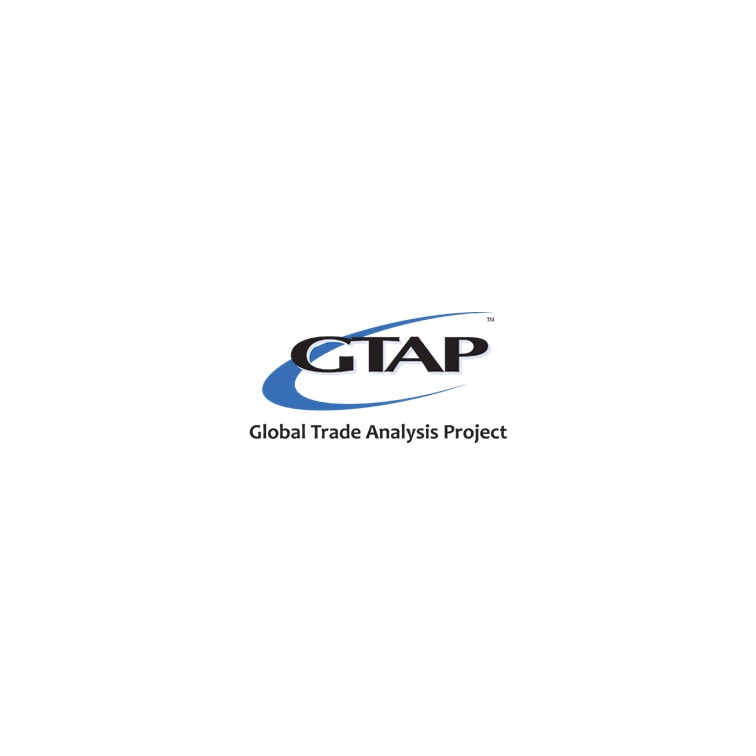GTAP 10 全球貿易分析計畫

- GTAP 10 全球貿易分析計畫
-
類別經濟財金分析軟體
-
介紹GTAP(Global Trade Analysis Project, GTAP)模型為美國普渡大學教授湯姆斯·赫特所發展。依據澳洲Impact計畫以及SALTER計畫為理論基礎的該模型,適用範圍為全球貿易分析。
GTAP 10 Global Trade Analysis Program
The GTAP Data Base is not a relational database of economic variables. Users interested in economic data only for comparative purposes are better served by sources such as the World Bank Development Indicators (WDI), the International Monetary Fund (IMF) financial statistics, or the Food and Agriculture Organization (FAO) statistics, to name a few. The data in the GTAP Data Base accurately depicts the magnitudes of economic variables, but they are presented in terms of the aggregates that serve Computable General Equilibrium (CGE) modeling.
What is the GTAP 10 Data Base?
The centerpiece of the Global Trade Analysis Project is the GTAP Data Base, a fully documented, publicly available global database containing complete bilateral trade information, transport and protection linkages. The GTAP Data Base represents the world economy and is utilized by thousands worldwide as a key input into most applied general equilibrium (AGE) analysis of global economic issues. An overview of GTAP 10 is available from the open access Journal of Global Economic Analysis at https://www.jgea.org/resources/jgea/ojs/index.php/jgea/article/view/77

系統需求
The standard GTAP Model is implemented using GEMPACK (General Equilibrium Modelling Package) and therefore a GEMPACK license is required to modify the standard GTAP Model. The Centre of Policy Studies (CoPS), Australia develops and supports GEMPACK. GEMPACK licenses must be obtained from CoPS.
Supplied with RunGTAP are the current version of the GTAP Model (GTAP.TAB), a standard condensation of the model (GTAP.STI), and the associated GTAP.EXE, which is used to solve the model.
If you do not want to omit or backsolve/substitute any of the
variables, you may use the uncondensed version of the GTAP
Model (GTAPu.TAB and GTAPu.EXE), which is also available with
RunGTAP. If you need to change the theory of the model (that is, change GTAP.TAB) or if you need to change the condensation
(for example, to un-omit/omit different variables or to do different substitutions or backsolves), you need to change GTAP.EXE.
You can only
do that if you have a GEMPACK license since you will need to
run the GEMPACK program TABLO. More precisely,
• You can make a new GTAP.EXE if you have a Source-Code
Version of GEMPACK.
• If you have an Executable-Image Version of GEMPACK, you
can solve GTAP using the GEMPACK program GEMSIM. Then
you need to run TABLO to produce the GEMSIM Auxiliary files
GTAP.GSS and GTAP.GST (which reflect your modified TAB file
and/or condensation).
• If you have only the Limited Executable-Image Version
(this is the version supplied at the GTAP Short Courses),
you will only be able to solve for up to about 9x9 (or even
smaller if you un-omit variables).
• But you can solve for any aggregation if you have the
Unlimited Executable-Image Version of GEMPACK.

GTAP 10 全球貿易分析計畫
GTAP數據庫不是一個經濟變量的關係數據庫。 GTAP數據庫中的數據準確度地描述了經濟變量的大小,但它們是用於計算總體均衡(CGE)建模的數據來表示的。
什麼是GTAP 10數據庫?
全球貿易分析項目的核心是 GTAP 數據庫,它是一個有完整完整數據的、公開的數據庫,包含完整的伙伴關係信息、運輸和保護。GTAP 數據庫代表世界經濟,並被葡萄酒數以千計關於GTAP 10的概述可從開放性的《全球經濟》雜誌中獲得,網址為的人利用,作為全球經濟問題的大多數應用分析總體均衡(AGE)分析的關鍵輸入。

Microfit 5.5 計量經濟學分析軟體
Microfit 是用於計量經濟模型建立的軟體.程式是由劍橋大學的經濟學家Dr.Hashem Pesaran和Dr.Bahram Pesaran所設計,新增的數據分析功能,可以預估設計高等的單變異數(Univariate)及多變異數 (multivariate)時間序列的模型.Microfit的使用手冊包含了多個教學範例,使用多種不同的財務及經濟數據 .Microfit 是交談式,由選單驅動的評估預測軟體.非常適合企業,銀行,教學及研究使用.
Eviews 13 時間序列分析軟體
EViews 通過一個創新的、易於使用的面向對象界面,為金融機構、公司、政府機構和學術機構提供強大的統計、時間序列、預測和建模工具。 親自了解為什麼 EViews 是計量經濟學軟件的全球領導者以及那些需要最好的人的選擇……
GTAP 10 全球貿易分析計畫
GTAP(Global Trade Analysis Project, GTAP)模型為美國普渡大學教授湯姆斯·赫特所發展。依據澳洲Impact計畫以及SALTER計畫為理論基礎的該模型,適用範圍為全球貿易分析。

